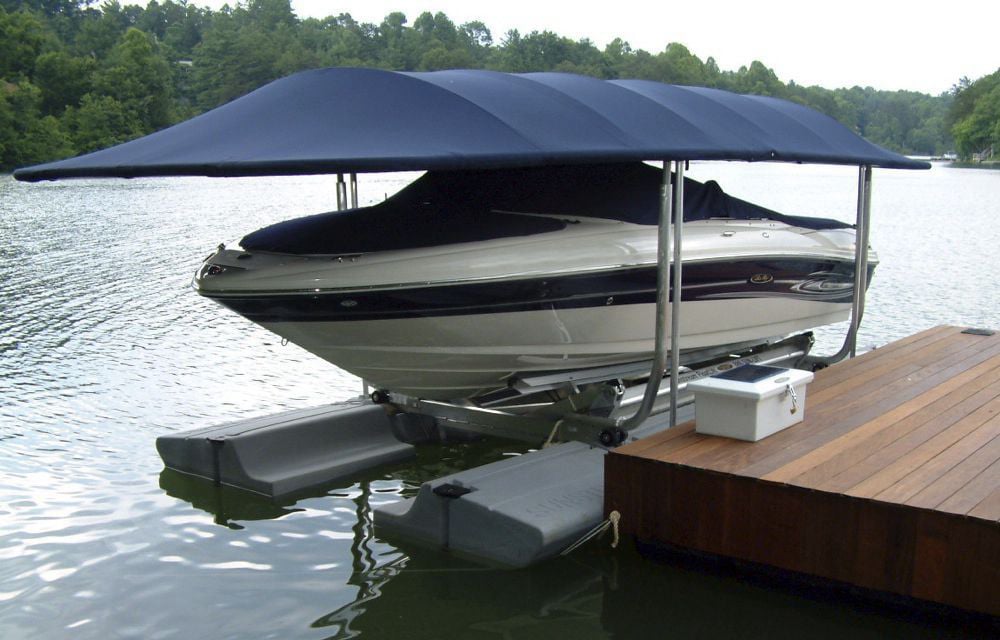What is a Floating Boat Lift?
A floating boat lift is a type of marine equipment designed to raise your boat out of the water when it's not in use. Unlike
traditional boat lifts that are fixed to a dock or shoreline, floating boat lifts are buoyant structures that support the boat while keeping it elevated above the water level. These lifts use buoyancy to provide support, typically through air-filled chambers or foam-filled pontoons.
Advantages of Floating Boat Lifts
Protects Against Marine Growth: By keeping your boat lifted out of the water, floating boat lifts help prevent the growth of algae, barnacles, and other marine organisms that can attach to your hull and affect performance.
Prevents Hull Damage: Constant exposure to water can lead to osmotic blistering and corrosion of the hull. A floating boat lift mitigates this risk by keeping the hull dry when the boat is not in use.
Easy Access for Maintenance: Performing maintenance tasks such as cleaning, painting, and inspections becomes easier and safer with the boat lifted out of the water.
Convenient Launching and Docking: Floating boat lifts provide a stable platform for easy and quick launching and docking of your boat, reducing the hassle of maneuvering in tight spaces.
Preserves Resale Value: Regularly using a boat lift to keep your vessel out of the water can help maintain its appearance and structural integrity, which can positively impact its resale value.
Types of Floating Boat Lifts
Air-Filled Chambers: These lifts use inflatable air chambers to provide buoyancy. They are lightweight and easy to install, making them suitable for various water conditions.
Foam-Filled Pontoons: Pontoons filled with foam offer durable buoyancy and stability. They are more resistant to punctures and can support heavier vessels.
Modular Systems: Modular floating lifts consist of interconnected modules that can be configured to accommodate different boat sizes and shapes. They offer flexibility and scalability.
Considerations Before Installing a Floating Boat Lift
Water Depth and Conditions: Ensure that your water depth and local water conditions (such as tides, currents, and waves) are suitable for installing a floating boat lift.
Boat Size and Weight: Choose a lift that can adequately support the weight and dimensions of your boat. Consider future upgrades or changes in boat size.
Installation and Maintenance: Factor in installation costs and ongoing maintenance requirements. Regular inspections and cleaning will prolong the life of your lift.
Permitting and Regulations: Check local regulations and obtain any necessary permits before installing a floating boat lift. Some areas may have restrictions on waterfront structures.
Installation Tips
Professional Installation: While some lifts are designed for DIY installation, professional installation ensures proper alignment, anchoring, and buoyancy adjustments.
Anchor Securely: Use appropriate anchors and mooring lines to secure the lift in place, considering water depth, currents, and wave action.
Regular Maintenance: Inspect the lift regularly for signs of wear, corrosion, or damage. Clean debris and inspect buoyancy chambers or pontoons for leaks.
Floating boat lifts offer numerous benefits for boat owners seeking convenience, protection, and maintenance ease. By understanding the advantages, types, considerations, and installation tips outlined in this guide, you can confidently choose the right floating boat lift for your needs and enjoy more time on the water with less worry about your boat's maintenance and longevity. Whether you have a small pleasure craft or a larger vessel, investing in a floating boat lift can be a game-changer for your boating experience.
